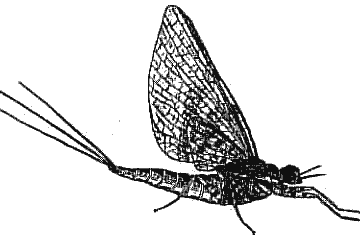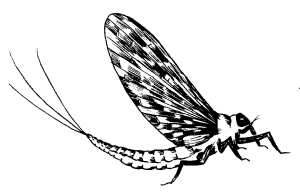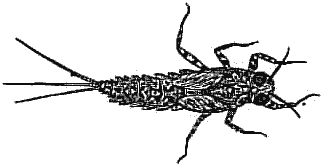 MAYFLIES MAYFLIES
article
by Ron Newman
Scientific
Name:
- Class
- Insecta. Order - Ephemeroptera. Suborders - Schistonota
or Pannota
Common
Names:
- Mayflies,
Mays, Upwings, Duns, Spinners, Dippers, Fish Flies

General:
- On our
Interior lakes, Mayflies are not as important a food source for trout
as they are in some other regions of the country. Our Mays are generally
on the smaller end of the size scale and tend not to hatch in the same
quantities as elsewhere in North America. The many types of Mayflies
are split into either the 'splitbacks' or the 'fusedbacks' with three
super families each. Those are then designated as to whether the nymphs
are swimmers, crawlers, burrowers, or clingers and often that is determined
by their habitat. With all this variety, the following description is
somewhat generic.
Life Cycle:
- Adults
swarm and mating flight. In these swarms the male adult will fly up
and down (dippers) while the female flies through the swarm. In this
pass-through, a male seizes a female and mating takes place. These mating
swarms generally occur at dawn or dusk. Eggs may be laid while the female
adult is in flight skimming over the water surface, or some species
will submerge below the surface to lay their eggs among the vegetation.
The egg hatches into a larva or nymph that will develop while hiding
on or under the lake bottom vegetation, and often will burrow into the
mud. The nymph will feed on organic matter while it grows. When the
nymph reaches maturity it will transform into a 'sub-imago'. The sub-imago
is what we see 'hatch' from nymphs. They are not an adult but are fully
winged. Before flight the sub-imago will rest while the wings dry. The
wings will be held upright and folded over the back. After taking flight,
the sub-imago usually rests on the shoreline vegetation for 1 or 2 days
while gradually transforming from sub-imago into adult (or imago or
spinner). The adult will not feed. After this transformation, the adult
will still take one to three weeks to become sexually mature. The sexually
mature adult will then mate within a few days and then immediately die.
The dead or dying adult will then lie on the waters surface with wings
spread and, at that point, is referred to as 'spent'. Most Mayflies
have one or two generations per year but this ranges from a couple to
weeks to a couple of years.
 Appearance: Appearance:
- Most of
the Mayflies on our interior lakes have two tails but some three tailed
species are present. These tails are visible throughout most of the
developmental stages. In the adult the tails are often as long as the
body. The sub-imago often sits on the water with its wings held upright
over the back as they dry. In this position they appear very triangular
in shape. After mating and laying their eggs, the adults die fairly
quickly and lie in the water with their wings spread out. In most species
the nymphs have gills along the sides of the abdomen, which tend to
give them a flattened appearance. There are generally 7 to 9 abdominal
segments with nine being the most common.
Size:
- On our
interior lakes, Mayflies are up to 20mm long (3/4 inch with tails) but
generally average about 10 to 15 mm (0.4 to 0.6 inches with tails).
On a few interior lakes, members of the larger species have been reported.
Colour:
- Colors
tend to darken as the life cycle progresses. For our interior species,
the most frequently found colors tend to be reddish brown to brown,
or to a slate color. However, they are found in a variety of other colors
including lime green. The wings of adults are semi-transparent.
Movement:
- Larva
burrow into substrates, crawl or cling to bottom plants and debris,
and often swim like a fish by sweeping motions of the abdomen and tail.
In swarming flights, the adults often go through "dipping" motions where
they seem to drop a ways and then regain altitude.
 Habitat: Habitat:
- Mayflies
require clean, unpolluted water that is generally well oxygenated. They
are one of the first aquatic species to disappear when water pollution
occurs. The use of gasoline motors on our lake and the resulting pollution
keeps the Mayfly population on most of our lakes relatively low. Mayflies
live in flowing or still water and occasionally can be found at depths
to 200 feet. The nymph feeds on algae, diatoms, and vegetable or organic
matter that have settled to the bottom. Since their food is mostly on
the bottom the larva are usually found on the bottom. They tend to burrow
into the bottom substrates and hide under rocks and vegetation.
Importance
to Fly Fishing:
- In most
parts of North America the Mayfly has always been considered as a main
or 'the' main staple food source of trout and many other species of
fish. I can't speak to historical records, but I know that this is not
the case on the interior lakes of British Columbia. Currently they rank
as seventh among the seven most important species for fly fishers. Mayflies
represent only two percent of the total feeding samples for fish I have
caught on interior lakes over the last twenty or so years. However,
in terms of 'observed' food they range around 10 to 14% of the feed,
which is fairly significant. They are obviously fed on by the trout
less often than they are available. Mayflies are taken slightly better
in the evening or after dark than they are during the daytime.
- I'm not
sure exactly why but the majority of fish feeding on mayflies, in all
stages of their life cycle, tend to be the smaller fish (generally less
than a pound in size). To me, that indicates 'opportunistic' feeding
by the growing immature fish rather than a 'seeking out' by all fish
as a primary food source.
Hatches:
- 'Hatches'
from nymph to sub-imago can begin in the last half of April at lower
elevations. These hatches peak about April 28th and the moderate to
high elevation hatches peak about June 10th. However, hatches continue
throughout the season. These hatches are known to happen right up until
the first fall frosts in about mid October. A secondary peak in hatches
occurs about August 3rd but feeding samples indicate that feeding on
this hatch actually peaks about July 23rd while still in the nymph stage
(but both are dependent on elevation). A significant number of other
hatches occur throughout the season but not of sufficient importance
to report as a separate incidence. It should be noted that a brood of
Mayflies may hatch "in mass" in a few hours or it may take several weeks
for the brood to complete a hatch.
- Hint:
Your are more likely to have success fishing Mayfly patterns during
the secondary hatch in late July to early August than during the peak
hatches. During the peak hatches, other food sources are also abundant.
In the late summer hatch, many of those other food sources are not readily
available to the trout.
Adults:
- The sub-imagos
and the spent adult are important to the fly fisher primarily as a dry
fly. Fly patterns for the sub-imago should be tied with the wings upright
as if ready to take flight. As a spent adult the fly should be tied
as if the insect were dying, with the wings flat to the water. Don't
forget to tie in two or three tails on these dry flies. Both types of
patterns are effective and the trout will readily feed on each of these
stages of the life cycle.
- Hint:
If fishing is slow, and you see some rises in the shallows, and you
have seen some Mayflies, and you are willing to catch the smaller fish,
try a dry Mayfly pattern (sub-imago) in the shallows. It will often
provide some excitement on what could otherwise be a slow day. On occasion,
even that larger fish may be taking the dry May.
Nymphs:
- The nymph
of the Mayfly is also an important stage to imitate for the fly fisher.
Larger fish are more likely to feed on the nymph than the sub-imago
or the spent adult on the surface. The nymph is available most of the
season, usually in shallow waters, on or near the bottom. A good nymph
pattern presented just at the start of a hatch can produce excellent
results for the fly fisher. The best success often comes when the nymph
is fished in the evening on the shallow shoals. After a major hatch
has commenced, it is a mixture of small to large fish that feed on the
nymphs and almost entirely the smaller fish that feed on mayfly sub-imagos
or adults. Get in at the beginning of a hatch to get the larger fish.
Additional
Notes:
- With their
susceptibility to pollution, Mayflies are a good indicator species for
the health of a lake. Since Mayfly populations are a main food source
in most parts of the country and not on our interior lakes, I hope this
isn't a statement on the condition of our interior lakes. Time will
tell. In the meantime maybe each of us can help prevent any further
lake pollution. Please don't use gasoline motors and avoid the use of
all motors in shallow waters. Don't pee over the side and avoid introducing
anything into the lake but your anchor. Mayflies can become a primary
food source for the large trout but it will take some work by all of
us.
Recommended
Fly Patterns:
- Larva
(Nymph):
- Tiny
Terror
- Little
Green
- Copper
Creek
- Western
Brown
- Halfback
- Dun:
- Tom
Thumb
- Mayfly
Dun
- Blue
Dun
- Green
Mayfly
- Spinner:
Be
sure to read other articles by Ron Newman
Study
Other Insects
| Tip & Techniques
| Study Fly Patterns
|



 MAYFLIES
MAYFLIES
 Appearance:
Appearance: Habitat:
Habitat: